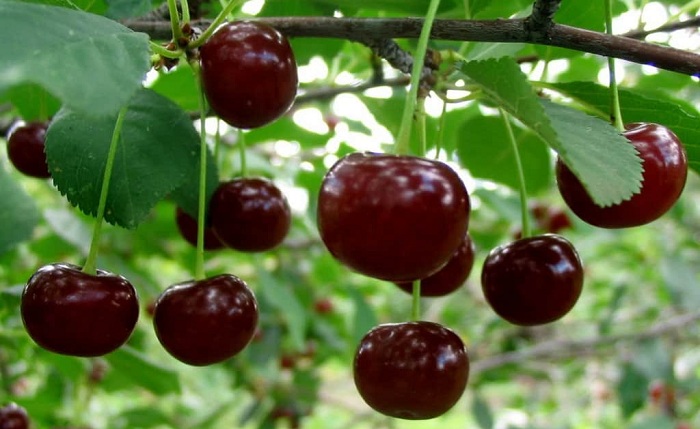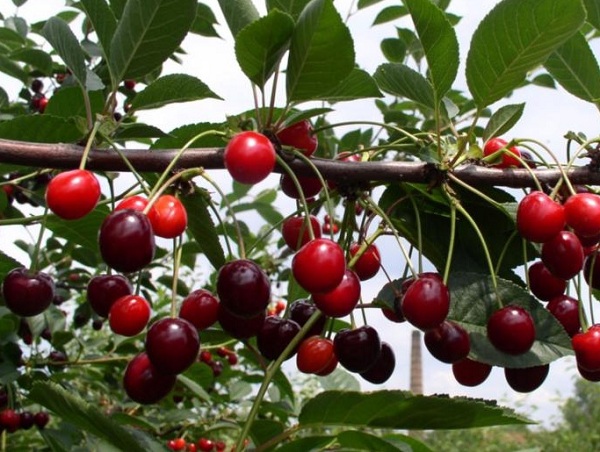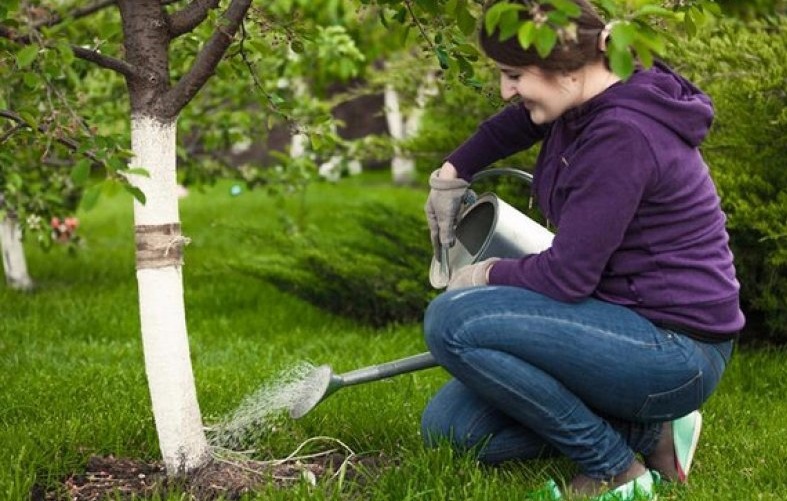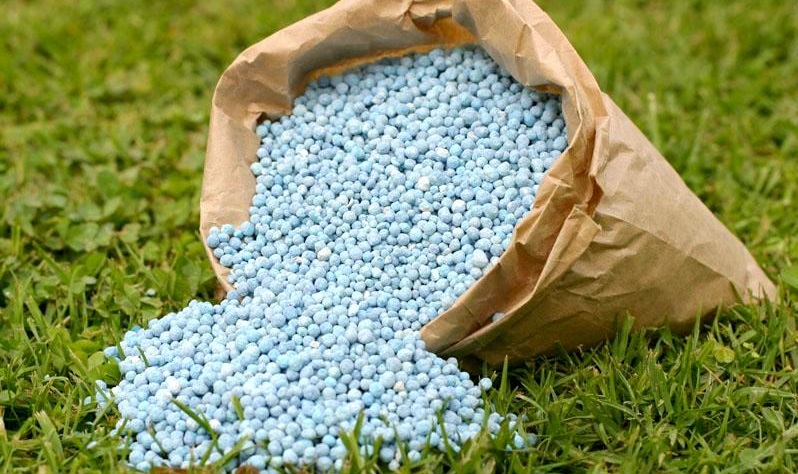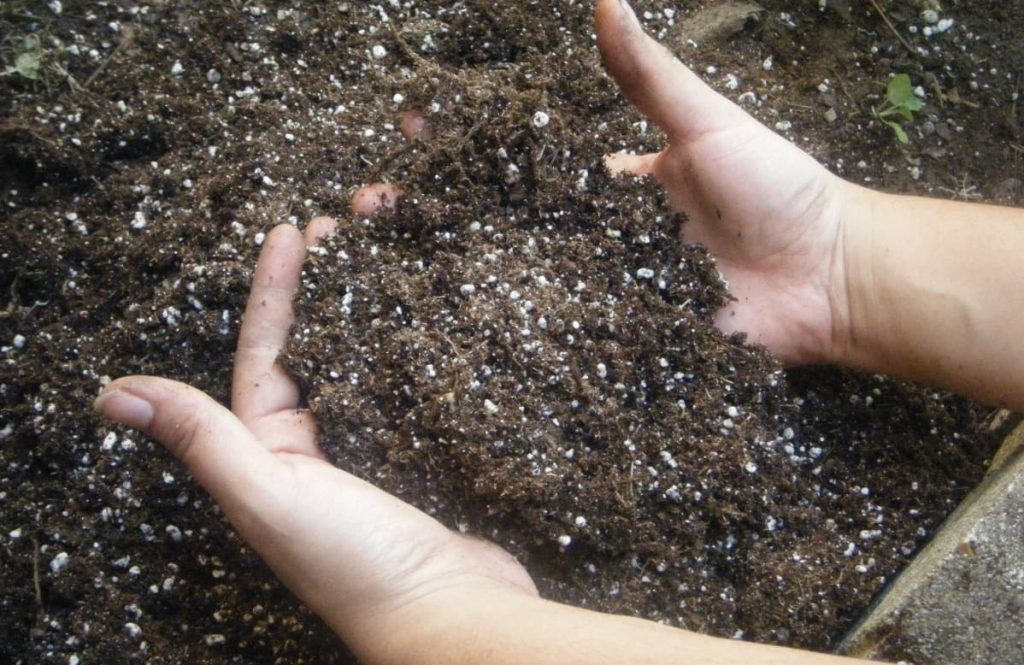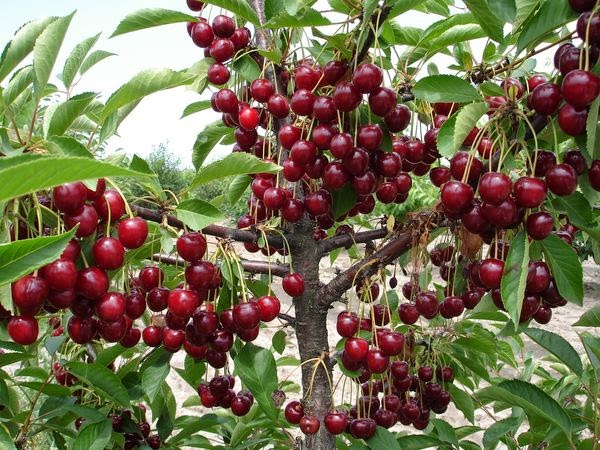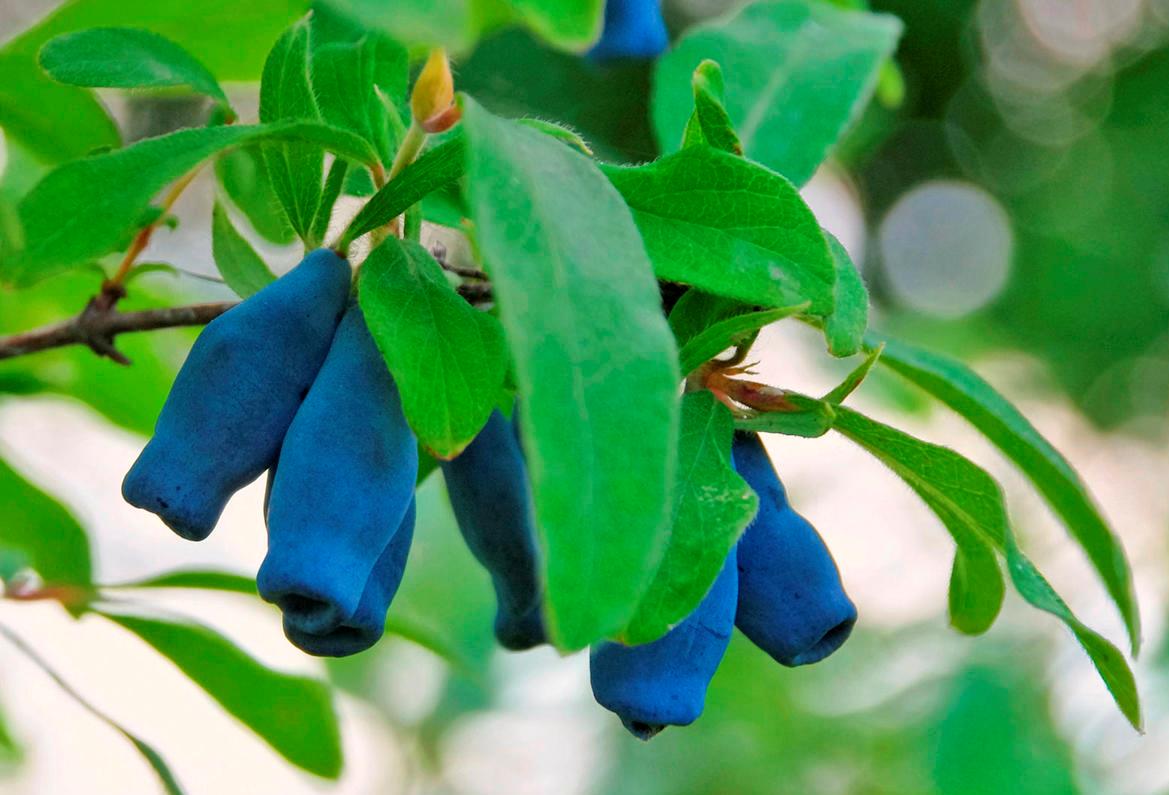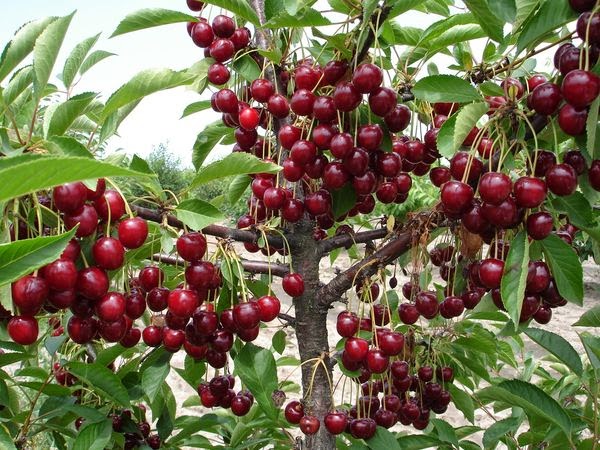Content:
Cherries are especially popular with gardeners, so they can be found on every household plot. This is explained not only by the unpretentiousness of the culture, but also by the high useful properties of the fruits. But in order for the tree to give a stable and generous harvest, you need to know how to fertilize cherries throughout the season, and when to feed them.
Features of culture
Cherry is a fast-growing crop, which, subject to the conditions of agricultural technology, gives the first harvest 2-3 years after planting in a permanent place. The tree has a short life span - from 10 to 15 years, but with the help of timely rejuvenation, this figure can be increased to 30 years.
Main types
Most often, tree-like and bush crops are grown on the personal plot. The former are distinguished by a single-stemmed crown and grow in height from 3 to 7 m. The tree reaches its maximum size by 6-8 years. Flowering and fruiting in this species occurs on bouquet branches, which increases the number of flower buds and prevents the branches from becoming exposed with age.
The latter form a crown in several trunks, as a result of which the tree has a wide spreading shape, consisting of many small shoots. Flowering and fruiting of this species occurs on the growth of the last year. The life span of a tree is 12-15 years, but if the requirements of the culture are not observed, this indicator can be reduced to 8-10 years.
The felt variety of bush cherries is especially popular with gardeners. This subspecies is distinguished by corrugated leaves, and also has a characteristic edge of the shoots of a gray shade, which visually resembles felt. The fruits are small in size, and taste sweet and sour. According to biological characteristics, the felt cherry resembles a plum, and therefore can be crossed with peach, cherry plum and apricot. The subspecies is distinguished by abundant annual fruiting.
Popular varieties
The main condition for obtaining a generous harvest of the fruits of this culture is the correct choice of the variety. The most common tree disease is coccomycosis, so gardeners prefer to choose highly resistant species.
Common varieties:
- Miracle cherry - is a hybrid of cherry and sweet cherry with an early ripening of fruits, it is considered one of the sweetest varieties.
- Turgenevka - forms a tree, the height of which reaches 3 m, dark red fruits have a mass of 5 g. High winter hardiness and relative resistance to diseases.
- Amorel Nikiforovna is a tree-like species with increased frost resistance. Fruit ripening occurs in the second decade of June.
- Freezer - forms a tree of medium height with a lush crown. The size of the berries reaches 6 g. The taste is sweet and sour, so the variety is suitable both for fresh consumption and for preservation.
- Beauty is a felt cherry variety, the yield reaches up to 10 kg per bush. In the absence of annual pruning, the fruits become smaller.
- Damanka is a felt cherry with high resistance to frost and drought. The yield reaches 12-14 kg per bush.
- Moscow griot - has an average crown size, needs additional pollination.When ripe, the berries acquire a dark red hue and sour taste. Possesses excellent frost resistance. With good care, the yield reaches 1000 kg from 1 are.
Spring feeding of cherries
In order for the cherry orchard to consistently bear fruit, it is necessary to take care of the application of fertilizers at different stages of development. But how to feed the cherry in spring, and in what period to do it, you should figure it out. This stage of care requires special care of the gardener, since as the tree develops, the need for a different complex of microelements increases significantly.
The main types of dressings
Fertilizing cherries in the spring should be carried out several times. The procedure can be carried out by root and foliar method. This helps to speed up the growth of the shoots after winter, and also improves performance later on.
The main methods of root fertilization for cherries:
- Dry scattering - granular mineral mixtures, interacting with moisture in the form of dew and rain, gradually dissolve and penetrate deep into the soil, which contributes to the nutrition of the root system.
- Watering the tree - feeding is carried out with an aqueous solution. This type of feeding facilitates quick access of the necessary nutrition to the roots. But fertilizer cannot be stored in this form, therefore, having prepared a solution, it is necessary to immediately water the trees.
- Laying mulch near the base of the tree - this method helps to enrich the soil with necessary trace elements, and also prevents excessive evaporation of moisture. For mulch, you can use straw, peat and humus.
You can also fertilize cherries by foliar method. In this case, the trees should be treated by spraying on the leaf and shoots. It is effective to use this procedure simultaneously with prevention of pests and diseases, which helps the gardener to reduce the number of spring treatments.
Fertilization feature
As cherries develop, the tree's need for a particular trace element changes. Young seedlings in the first and second years do not need additional nutrition, if the whole complex of fertilizers was applied during planting. But as it grows further, the root system expands and therefore the need for feeding increases.
The type of fertilizer applied largely depends on the structure of the soil. Cherry planted in black soil may not be fertilized for the first three years, since the soil contains all the necessary trace elements in an accessible form for the plant. It is enough only to sow green manures in the near-trunk circle, followed by their embedding in the soil in the fall for maturing. This will help improve the structure of the soil and enhance the growth of the seedlings.
A tree planted in clay and sandy soil should be mulched at the base with rotted manure or plant residues for the first two years.
Mature trees should be fertilized at least 3 times each year. But how to feed cherries in spring so that they bear fruit stably should be studied in advance.
Fertilizers
You can fertilize cherries in the spring with mineral complex compounds and organic fertilizers. Each of the presented species helps the tree to recover after winter, start active vegetation, promotes abundant flowering and accelerates the formation of fruits, and increases the yield.
But before deciding what exactly to feed the cherry, you should figure out what to bring in first and what to use in the future.
The main types of fertilizers.
- Organic (manure, chicken droppings, green compost). This type of fertilizer is notable for its availability. It is recommended to use it in early spring, which will allow the tree to actively grow.
- Nitrogen (urea, calcium nitrate, ammonium nitrate). This type of mineral fertilizer helps the tree to grow green mass. Application is carried out by scattering granules on the ground along the entire perimeter of the crown.
- Phosphoric (superphosphate, ammophos, diammophos). The presence of this type of fertilizer guarantees a full-fledged metabolism in the tissues of the tree, and also provides access to microelements from the root to the crown and vice versa. Top dressing in this case can be carried out both by root and foliar method.
- Potash (potassium sulphide, potassium nitrate). This type of feeding affects the quantity and quality of the fruit. Timely application of potash fertilizers accelerates the ripening of fruits and improves their quality. They can be introduced in combination with other means by watering or spraying.
- Folk remedies (wood ash). This type of fertilizer is recommended to be used as an addition to the main food.
Stages of the
How to fertilize cherries? Cherry feeding is carried out according to a scheme that includes three main stages: during the period of active growth of shoots, during the formation of buds and immediately after flowering. Each of them has its own characteristics and composition of fertilizers. Therefore, before starting the procedure, you should study the timing of its implementation and familiarize yourself with how to fertilize cherries and cherries in spring.
First step. In this case, fertilization should be planned as soon as the tree begins to open its first growth buds. This will help the plant to regain strength after winter and enter into active vegetation. At this stage, you can use organic matter by scattering rotted manure under the tree at the rate of 5 kg per crop.
Second phase. Fertilization in this case should be complex, as the tree is preparing for flowering. Therefore, it is best to use the following composition of components for 10 liters of water:
- superphosphate - 50 g;
- urea - 25 g;
- potassium sulfate - 40 g;
- bird droppings - 100 g.
Insist the remedy for a week and then spray or water the cherries. A mature tree needs 2-3 buckets of this nutrient mixture.
Stage three. Adequate nutrition during this period contributes to a full fruit ovary. In this case, you can apply both root and foliar feeding. The best option may be wood ash extraction. To do this, it is necessary to insist 100 g of the component in 1 liter of boiling water for 24 hours. After that, add 9 liters of water and use as directed.
In the absence of this folk remedy, you can use the following fertilizer composition for 10 liters of water:
- superphosphate - 30 g;
- urea - 15 g;
- potassium sulfate - 40 g.
As an addition to the main stages of feeding, it is recommended to spray the shoots with iron sulfate. This procedure helps not only to provide plants with the necessary components, but also prevents the development of fungal diseases. Trees are processed in late autumn or early spring on bare branches. The consumption rate is 300 g of powder for 10 liters of water.
Cherry feeding rules
Fertilization implies compliance with certain rules, which guarantees the full development and fruiting of cherries.
- You can mulch trees with organic fertilizers only after the soil has thawed, otherwise this procedure will not bring any benefit.
- In a drought, fertilizers should be used in the form of watering or spraying, since the scattering of granules does not guarantee the access of trace elements.
- Root fertilization should be carried out on moist soil to avoid scalding the roots.
- The last application of nitrogen fertilizers should be in May, as their later application may negatively affect the cherry yield.
- For foliar application, the concentration of the working solution should be halved. Before carrying out, you should spray one small branch and wait 2 hours, if no negative consequences have been identified, then you can process the entire tree.
- If the cherry begins to shed leaves or ovary, then this indicates a lack of potassium. In this case, an extraordinary phosphate-potassium supplement should be applied.
- Mulch should be laid 15 cm thick, but placing the layer not close to the trunk, as this leads to heating of the bark and stimulates the appearance of fungal diseases.
Fertilizing cherries in spring is the main condition for the successful development and stable yield of the tree. But the excessive introduction of nutrients, like the lack, negatively affects the culture. Therefore, any disregard for the norms and terms of depositing funds can lead not only to a lack of harvest, but also to the death of cherries.
